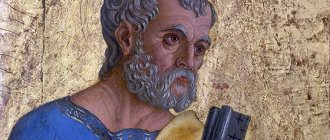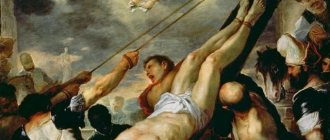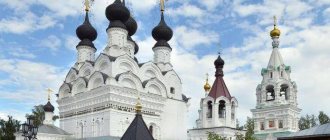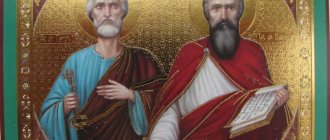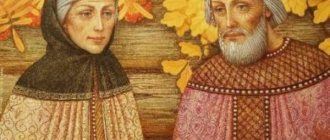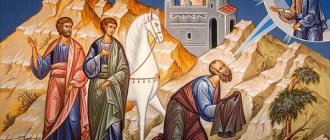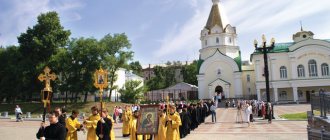What is the Apostle Peter famous for?
Photo: Ru.Wikipedia.org
Saints Peter and Paul are among the most famous apostles and zealots of the Christian faith. Moreover, their characters were complete opposites. If one was distinguished by his oratory skills, then the second was a simple but very inspired person.
In the world, Peter was called Simon. The apostle received the name by which he became known to all Christians from Jesus Christ. Translated from Hebrew it means “stone.” Peter was a simple-minded and sincere person who did not have an outstanding education. At the same time, he was distinguished by his hot temper and amazing imaginative thinking. Often he gave speeches that made people rise up and follow him.
Peter is a direct participant in many episodes that are mentioned in Holy Scripture. One of the first miracles of Christ was the healing of the mother-in-law of the future apostle. He also participated in fishing, when, thanks to Jesus, there was a huge amount of catch.
Later, Peter became an eyewitness to the Transfiguration of the Son of the Lord; before his arrest, he swore that he would never renounce his teacher, but he broke his word just a few hours later, more than once. He repented of his action, found the courage to admit his betrayal, his own weakness in the face of circumstances. When Peter repented, the Lord confirmed his apostolic title.
They began to venerate him together with Paul after the execution of the apostles. Both died as martyrs, and the place of their execution was recognized as sacred. The Church has always glorified the spiritual strength of Peter, creating around him the image of a sinner, but sincerely repentant believer.
The letters of the Apostle Peter were included in the New Testament of the Bible, there are two of them
In the years 63 and 67, the Apostle Peter wrote his Council Epistles, which were included in the New Testament.
In the first part of the epistles, he strengthens newly converted Christians in the faith, admonishing them not to be embarrassed by threats, slander and persecution. He teaches prudence, prayer and piety. In the second letter, the Apostle calls not to retreat in faith to please the pagans, denounces false teachers and false prophets, warns and protects Christians from the errors of lawless people.
Quote from the message:
(1 Peter 1:13-16)
“Therefore, (beloved), having girded up the loins of your mind, being watchful, have complete confidence in the grace that is given to you at the appearing of Jesus Christ. As obedient children, do not conform to your former lusts that were in your ignorance, but, following the example of the Holy One who called you, be holy in all your actions. For it is written: Be holy, for I am holy.”
The letters of the Apostle Peter confirm Christians in faith, piety and firmness of conviction.
Handing over the keys to heaven
Photo: Ru.Wikipedia.org
As a result, the Lord decided to hand over the keys to heaven to the most unstable and ardent of his disciples. Scripture notes that none of the apostles who sinned received the keys. Instead, they went to Peter so that in the future he would be able to discern sincere repentance in sinners, and then remember his own fall.
It is such an apostle who is truly able to help a person who sincerely repents of his sinful actions receive salvation.
The tomb of the Apostle Peter was found in the 20th century
Christian tradition has preserved information that the ancient Roman basilica of Constantine was located at the site of the supposed burial of the Apostle. Archaeological excavations carried out in 1939-1949 discovered ancient remains, and a stone with the inscription “Here lies Peter.” The research report reflects the assumption that, with a high probability, the remains and grave belonged to the Apostle. After studying the materials, in 1968, Pope Paul VI announced the discovery of the tomb of the Apostle Peter.
The veneration of the Supreme Apostles Peter and Paul takes place on June 29.
By leaving a comment, you accept the user agreement
Guardian of Heaven's Gate
One of the fairy tales of the Brothers Grimm tells about a poor tailor who once knocked on the gates of heaven where the Apostle Peter stood. The tailor asked the saint for a pass to heaven. The Apostle Peter reluctantly allowed the tailor to go to this beautiful place, but warned him to be quiet, otherwise he would be kicked out of paradise.
But the curious tailor could not keep his promise - he began to examine the heavenly abodes and found a beautiful golden chair, next to which stood a golden footstool.
From here you could see the whole earth, and the tailor noticed a little old woman by the lake. She washed someone else's clothes and saved herself a couple of good things. The tailor decided to punish the thief and threw a golden bench at her. Soon the Lord returned and asked where his bench had gone. The Apostle Peter pointed to the little tailor, and he began to justify himself before God:
“I saw the thief and in anger threw a bench at her.
“If I started throwing benches at sinners out of anger, then there wouldn’t be a single object left in heaven.” You had no right to judge people, so the Apostle Peter will expel you from heaven right now.
The tailor was banished from heaven forever for judging another person.
Favorite Saint and Living Faith
Each era has its own favorite saints. If fairy tales and legends were being written in Russia now, the main characters in them could be the Monk Seraphim of Sarov, the blessed Matrona of Moscow or the bishop-doctor Luka (Voino-Yasenetsky). And in those days when the Brothers Grimm or Alexander Afanasyev collected and processed fairy tales and legends, the favorite saints were St. Nicholas the Wonderworker, St. Elijah of Murom and the Apostle Peter - a simple fisherman, an ardent man, but sincerely repenting of his sins.
From the pages of the Gospel, he, together with Christ, stepped into the everyday life of rich and poor, kings and peasants.
And there is no need to be afraid that the “fairytale” Apostle Peter is not like the “gospel” Peter. The popular faith only highlighted some of the features of the supreme apostle, fell in love with them and made it so that this saint became part of any home.
As long as such heroes remain in the hearts of the people, our faith is alive.
The Apostle is the hero of fairy tales and jokes
The German fairy tale “The Tailor in Paradise”, the ancient Russian story about a drunkard who went to heaven, other fairy tales of the Brothers Grimm, Russian folk legends collected by Alexander Afanasyev - in all these books you can find stories about the Apostle Peter, who heals princesses and helps a poor soldier , together with Christ, enters the houses of Russian peasants, performs miracles, helps the poor, punishes sinners and even argues with the Savior.
Of course, the fabulous Apostle Peter bears little resemblance to the Peter about whom the Gospels and Acts of the Apostles tell. In Russian and German fairy tales, Peter descends from heaven to earth, turns into a beggar, asks for alms, punishes the stingy and rewards the generous. But the main job of the fabulous apostle is to stand in front of the gates of Paradise, let in the righteous and drive away unrepentant sinners.
This folklore image is alive even today. It is present in jokes, especially when it comes to business oligarchs striving to get to heaven for money. Such an apostle Peter can forgive a sinner, but he does not tolerate lies, deceit and self-justification.
Such a deep degree of penetration of the Gospel saint into oral folk culture is an excellent example of how deeply the Gospel and church tradition are deeply rooted in our consciousness, regardless of the degree of church membership and attitude to faith. However, an important question arises: why Peter, why exactly did this holy apostle conquer the hearts of the people?
Gates of Heaven
Holy Apostle Peter, mosaic of the baptistery, Ravenna (5th century) The Holy Scripture compares the temple of God with paradise. In the vision of the prophet Ezekiel, the Garden of Eden grows on the banks of a river flowing from the temple: “From under the threshold of the temple water flowed to the east, for the temple stood facing east, and the water flowed from under the right side of the temple, on the south side of the altar... By the stream along its banks, on both sides, all kinds of trees will grow that provide food: their leaves will not wither, and their fruits will not be exhausted; Every month new ones will ripen, because the water for them flows from the sanctuary; their fruits will be used for food, and their leaves for healing” (Ezek 47:1-12). The garments of paradise are similar to the vestments of the high priest: “You were in Eden, in the garden of God; your garments were adorned with all kinds of precious stones; ruby, topaz and diamond, peridot, onyx, jasper, sapphire, carbuncle and emerald and gold” (Ezek 28:13).
The connection between the temple and paradise is mentioned in the book of Jesus, son of Sirach, the Revelation of John the Theologian, as well as apocryphal texts and the works of the Church Fathers.
“Paradise Eden is the holy of holies and the dwelling place of the Lord” (Book of Jubilees or Lesser Genesis, chapter 8).
“The mystery of paradise is depicted by Moses, who built two sanctuaries - the holy and the holy of holies. Access to the outer sanctuary was always free, but entry into the inner sanctuary was only allowed once. Thus, God closed the interior of paradise for Adam, and opened the exterior, so that he could be content with the exterior.
Since Adam was not allowed to enter the inner temple, this temple was guarded so that Adam would be content with serving in the outer temple, and as a priest serves, bringing a censer, so he would serve, keeping the commandment.
The tree of knowledge was for Adam the image of a door, the fruit was a curtain that covered the temple. He who planted the tree of knowledge placed it in the midst, so that it would separate the highest from the lowest, the holy and the holy of holies.
Adam approached, dared to enter, and was horrified. Just as King Uzziah was covered with leprosy, so Adam exposed himself; and since he was struck like Uzziah, he hastened to leave.
Adam, in his uncleanness, wanted to enter the Holy of Holies, which loves only those like him; and since he dared to enter the inner sanctuary, he was not abandoned in the outer one.
Speaking about the symbolism of Byzantine worship, Saint Simeon of Thessalonica explains: “The splendor of the temple means the beauty of paradise, because the divine temple depicts paradise, or better said, represents the heavenly gifts of paradise...
At the beginning of prayers, we stand outside the temple, as if outside paradise or heaven itself. When the gates open at the end of the songs sung outside the temple, then we enter the divine temple, as if into paradise or heaven. This action means that the heavenly villages have been opened to us and we have already gained access to the Holy of Holies, we are ascending to the light, and approaching, we are approaching the throne of the Lord...
Standing and singing outside the temple expresses our expulsion from paradise... Litia happens outside the temple and indicates our falling away from paradise” (St. Simeon of Thessaloniki, Conversation on sacred rites and sacraments of the church, chapters 108, 123, 505 and 515). In modern Russian Orthodox worship, before the beginning of Vespers, the royal doors are opened and the clergy begin to cense the altar. When the 103rd Psalm is chanted, the entire temple is censed. These sacred rites symbolize the creation of the world and the blissful stay of Adam and Eve in paradise. Then the royal doors are closed, just as the doors of heaven were closed after the fall of people. The opening of the royal doors during the singing of the dogmatist (Theotokos) means that through the incarnation of the Son of God from the Blessed Virgin Mary and His descent to earth, the doors of paradise were opened for us. (On the meaning of the all-night vigil and the Divine Liturgy).
According to legends, the Jerusalem Temple was built on the site where the ancestors expelled from paradise worshiped (Louis Ginzberg, The Legends of the Jews, vol. 5). The temple was divided into three parts - the vestibule, the sanctuary and the holy of holies. Precious trees were used to decorate the temple - cedar, cypress and pevg (2 Chron 2.8). These trees were considered paradise (Ezek 31:8).
The symbol of the Garden of Eden was the golden seven-lamp lamp: “And he made a lampstand of pure gold, a hammered lamp he made; its stem, its branches, its cups, its apples, and its flowers came out of it; six branches came out of its sides” (Exodus 25.31-40; 37.17-24).
Cherubs and palms. An ancient bronze plate from South Arabia The cherubs, palm trees and flowers depicted on the walls of the temple also reminded one of paradise (1 Kings 6.18, 29, 32, 35). These images were decorated with gold and precious stones: “Solomon made carved cherubs and palm trees and blossoming flowers and overlaid them with gold; covered both the cherubim and the palm trees with gold... And he carved out the cherubim and the palm trees and the blossoming flowers and overlaid the carvings with gold” (1 Kings 6.32, 35); “And he overlaid the house of God with costly stones for beauty” (2 Chronicles 3:6).
The cherubim were depicted with the faces of a man, a lion, a calf and an eagle: “Lions, oxen and cherubim were depicted, and above and below the lions and oxen were spreading wreaths” (1 Kings 7.29); “From the top of the doors, both inside and outside the temple, and all around the wall, inside and outside, there were carved images, cherubs and palm trees were made: a palm tree between two cherubs, and each cherub had two faces. On one side, a human face is facing the palm tree, and on the other side, a lion’s face is facing the palm tree; this was done all around the temple” (Ezek 41:17-19).
The question of the presence of images of cherubs “outside,” that is, on the outer walls of the Old Testament temple, remains open to debate. “None of the ancient texts of the Old Testament, except for the version of the Greek text accepted by the publisher A. Ralphs as the main but little widespread edition, speaks of any external sculptural decoration of the temple” (A.M. Vysotsky, Ezekiel’s Temple as a source of external sculptural decoration decor of Vladimir-Suzdal churches of the XII-XIII centuries: sic et non, Old Russian art: Rus' and the countries of the Byzantine world, XII century, St. Petersburg, 2002). Although textual research shows that in most editions of the Old Testament there is no textual version of the Septuagint about the carved decorations of the facades of the temple, images of cherubs with animal faces were part of a single iconographic program of external temple utensils. Images of bulls, lions and cherubim decorated the copper sea (1 Kings 7:23-25) and the laver stands (1 Kings 7:29, 36). Such images corresponded to the idea of cherubs as guardians of the sacred territory of the temple.
The faces of cherubim were embroidered on the curtain that covered the entrance to the Holy of Holies (Exodus 26:31-33). The Holy of Holies was guarded by gilded sculptures of cherubim made from olive wood (1 Kings 6.23-28).
Pure gold, completely covering the Holy of Holies (1 Kings 6.20), showed an image of the radiance of the Glory of God.
The ancient symbols of heaven were inherited by Christian church art. Orthodox churches are decorated with mosaics, frescoes, icons, carvings and floral decorations.
Orthodox iconography includes heavenly palms, flowers and plant designs, for “the righteous blooms like a palm tree, rises like a cedar in Lebanon. Planted in the house of the Lord, they bloom in the courts of our God” (Ps 91:13-14). Old Testament descriptions of images of angels, palm trees and flowers can be compared, for example, with Byzantine mosaics of the Basilica of San Apollinaris Nuovo in Ravenna (6th century), representing processions of martyrs and martyrs in the Garden of Eden. The green meadows under the feet of the saints are dotted with lily flowers. Between the figures of Christian ascetics are palm trees, symbolizing eternal life. During the period of the iconoclastic heresy in Byzantium, Old Testament symbols of paradise were depicted instead of icons, so that churches, according to contemporaries, “turned into gardens, flower beds and poultry houses.”
Adam was called to “till and keep” the Garden of Eden (Gen. 2:15). After the fall of people, cherubim became the guardians of paradise: “And God drove out Adam and placed in the east by the garden of Eden a cherubim and a flaming sword that turned to guard the way to the tree of life” (Gen. 3.24). The Holy Scripture compares the cherubim with the guards who stood at the gates of the temple: “And Jehoiada the priest appointed porters at the gates of the house of the Lord, so that for no reason the unclean could enter in” (2 Chronicles 23.18). In the New Testament, the High Priest, the Lord Jesus Christ, entrusted the keys to the gates of heaven to His Church: “I tell you: you are Peter, and on this rock I will build My Church, and the gates of hell will not prevail against it; and I will give you the keys of the kingdom of heaven: and whatever you bind on earth will be bound in heaven, and whatever you loose on earth will be loosed in heaven” (Matthew 16:18-19). This is why saints, not cherubs, are depicted between palm trees on the walls of early Byzantine temples. For example, in one of the Byzantine mosaics of Ravenna, Saint Apostle Peter, standing between palm trees, holds in his hands the keys of the Kingdom of Heaven.
The Orthodox tradition also preserved images of cherubs with the faces of a man, a lion, a calf and an eagle. In the iconography they indicate the four evangelists - Matthew, Mark, Luke and John.
In Byzantium, rivers of paradise were depicted on the floors of temples.
Procession of martyrs, mosaic of the Church of St. Apollinaria Nuovo, Ravenna (VI century) It is significant that St. Ephraim the Syrian compares the trees of paradise with the veil of the Old Testament tabernacle and temple. In the altar of the Church of Boris and Gleb in Kideksha, images of shrouds dated to the 12th century, decorated with seven-branched candlesticks and trees, were cleared (V.N. Lazarev, Painting of Vladimir-Suzdal Rus'. History of Russian Art. Volume 1, M., 1953). According to M.A. Orlova, the shrouds with seven-branched candlesticks and trees are associated with the symbolism of the veil of the Old Testament tabernacle and temple: “The surviving part of the image of the white board is decorated with amazing ambiguity. The connection with the image of the Old Testament tabernacle was revealed and emphasized by the seven-branched candlesticks represented on it, and the image of a vine was reminiscent of the atoning sacrifice" (M.A. Orlova, On fragments of ornament and some decorative techniques in the paintings of churches of the Vladimir principality. Demetrius Cathedral in Vladimir: by 800- anniversary of creation, M., 1997). On the facades of the Demetrius Cathedral in Vladimir (12th century), an arcature-columnar belt with palm trees and saints creates a symbolic border of the temple as the New Jerusalem. This iconographic motif found its original embodiment in the iconostasis. The iconostases of Russian Orthodox churches combine the images of the veil and the Garden of Eden. In the iconostases, grapes, leaves and fruits of the trees of paradise, and flowers are woven into the general motif of a golden wonderful garden surrounding the iconographic images (Yu.N. Zvezdina, Floral decor of late Russian iconostases, “Iconostasis. Origin - development - symbolism”, M., 2000).
No sculptural images were allowed in Russian iconostases, except for carved gilded cherubs. Obviously, this exception was made under the influence of the Old Testament sculptures of cherubim that decorated the ark of the covenant and the holy of holies of the temple.
St. Simeon of Thessaloniki notes that in Byzantine churches there were multi-candlesticks that had the shape of paradise plants and the Burning Bush (St. Simeon of Thessalonica, Conversation on sacred rites and sacraments of the church, ch. 108). The seven-candlestick or seven-lamp lamp in the altar of a Russian church corresponds to the seven lamps that St. John the Theologian saw in the Heavenly Temple in a similar place - between the High Place (throne of the Lord) and the throne (altar).
Gold backgrounds, halos, assists, precious frames of icons show the action of Divine light emanating from the Heavenly Holy of Holies and transforming people and nature. The Lord Jesus Christ said about Himself: “I am the light of the world” (John 8:12), and about His disciples he said the same: “You are the light of the world” (Matt 5:14); “The righteous will shine like the sun in the kingdom of their Father” (Matthew 13:43).
John the Theologian testifies that in spiritual Jerusalem, descending from Heaven to earth (Rev 21. 1-2), at the Throne of God and the Lamb, a divine service is performed, which is similar to the divine service of the Orthodox Church. Therefore, the Orthodox church is called heaven on earth and the gates of heaven. “Thy will be done on earth as it is in heaven” (Matthew 6:10), the Church prays.
Recommendations
- "The College of Bishops and its Head, the Pope (para. 881)." Catechism of the Catholic Church
. Vatican Archives. - Mannion, Gerard; Mudge, Lewis S., ed. (January 30, 2008). The Routledge Companion to the Christian Church
. p. 235. ISBN 978-0415374200. - Joyce, George (1911). "The Power of Keys" Catholic Encyclopedia
.
8
. New York: Robert Appleton Company. Retrieved September 6, 2017. - Joyce, George (1911). "Chronological lists of dads." Catholic Encyclopedia
.
12
. New York: Robert Appleton Company. Retrieved September 6, 2017. - Joyce, George (1911). "Dad". Catholic Encyclopedia
.
12
. New York: Robert Appleton Company. Retrieved September 6, 2017.
Who will greet believers at the gates of Paradise?
Who will greet believers at the gates of Paradise?
Answer:
There are many angels at the gates of both Heaven and Hell. The Qur'an refers to these angels as Khazin, which means guardians. Therefore, this word should be considered not only as the name of these angels, but also as the position they occupy.
This is explained in detail in the following verses:
“Those who did not believe will be driven in droves to Gehenna. When they approach it, its gates will be thrown open, and its guardians will say to them: “Did not messengers come to you from among yourselves, who read to you the verses of your Lord and warned you to face this day of yours?” They will say: “Of course!” But the Word about torment came true regarding the unbelievers. It will be said: “Enter the gates of Gehenna and remain there forever!” How filthy is the abode of the proud! And those who feared their Lord are taken to Paradise in droves. When they approach and its gates open, its guards will say to them: “Peace be with you! You were good. Enter here forever!” (al-Zumar 39/71-73).
One of the rivayat reports that Khazin is the name of the angel standing at the gates of Paradise. It is reported that the Messenger of Allah (sallallaahu alayhi wa sallam) said:
“On the Day of Judgment I will go to the gates of Heaven and open them. Khazin will ask me: “Who are you?” I will answer him: “I am Muhammad.” Then Khazin will say: “I was ordered not to open this gate to anyone except you” (Muslim, Iman, 85).
Another hadith says:
“At night I saw two men who came to me and said: “The one who kindles Hell is Malik - his Guardian. I am Jibril, and this is Mikail” (Bukhari, 3236).
The name of this angel is also mentioned in the following verse of the Quran:
Who guards paradise?
Mysterious phenomena are not only the source of the Earth, which grants brief clairvoyance. For example, in winter it is warmer in Lalesh than in the neighboring village, and colder in summer. A special climate is preserved only here. According to teacher Lukman from the neighboring city of Shaikhan, this is due to the special design of the towers. “The five columns are like five rays of the sun, connected by energy. You can grow fruit here in winter.”
Having examined Lalesh and taking into account its coordinates, you can come to interesting conclusions. According to the point of view of most theologians, Eden (the biblical paradise where the first people lived - Adam and Eve) was located in Iraq. “From Eden came a river to water Paradise; and then divided into four rivers... The name of the third river is Tigris... The fourth river is Euphrates.” After Adam and Eve were kicked out of Eden, the Gardens of Eden were not wiped off the face of the earth. Paradise was sealed, a guard was placed at the entrance - a cherub with a flaming sword.
— Could the Yezidis be a secret society of guardians of the entrance to heaven? asks James McCornby, a history professor working on excavations in Alexandria. - Hmm, who knows. Look - the Yazidi religion prohibits its spread. The Yezidis are divided into three castes: sheikhs, who lead the services, pirs, the temple servants, and mrids, that is, the laity. Girls from the sheikh caste, for example, are not allowed to marry mrids. All the signs of a secret society are there. The serpent on the gates of Lalesh could also serve as a symbol of Eden - isn’t it the same one that led to the fall of Adam and Eve?
The Yazidis think differently: according to legend, during the Flood, a black snake plugged the leak on Noah’s Ark with its tail and saved the earth’s creatures from death. Anyway, we have two versions. According to the Yezidi Kurds, Lalesh is the founding place of the world. According to other signs, Eden is the former earthly residence of Adam and Eve. However, the main surprise is the revelation of the peacock angel's identity. Some believe that Melek Tavus is the same cherub left to guard the entrance to Eden. Others - what is this... Lucifer, cast out of heaven, but subsequently forgiven by God. The author expresses sincere gratitude to Amirkhan Mori, as well as Jemal Mori, for their assistance in preparing and organizing this report in Iraq.
Chief of Angels
The man in white clothes is sure: humanity originated here, in northern Iraq. Bave Chaves, a temple attendant from the Pir caste, leads me through Lalesh, a stone complex with pointed towers symbolizing the rays of the sun, and invites me to enter through a gate depicting a black snake. That's right, the temple is surrounded by a riot of greenery in the middle of the dead mountains, and this is not the last mysterious moment. Drinking water from the Zemzem underground spring in Lales is considered good luck, but the bride and groom should not go down into the cave with the spring - otherwise they will not get married, but will be brother and sister. The one who drinks from Zemzem will see a dream in which his future will be reflected. Getting to Lalesh is not easy - the fifty-degree heat heats up the car, the soldiers at the checkpoint twirl the Russian passport in their hands in amazement. Surrounded by checkpoints (Al-Qaeda militants have already tried to break through here), Lalesh is the only temple in the world of Yazidi Kurds, followers of one of the most mysterious and mystical teachings.
■ More than 30 thousand Yezidi Kurds, descendants of refugees from Turkey, live in Russia. ■ There are legends about other secret societies. For example, the “Society of Guardians of the Grail” (the cup in which Joseph of Arimathea collected the blood of Christ), as well as the “Winged Warriors” guarding the children of angels who supposedly lived on earth. ■ Some theologians believed that paradise was in India - the Tigris and Euphrates were allegedly named incorrectly, but in fact the Indus and Ganges rivers flowed from Eden.
Surprisingly, even the Yazidis themselves do not know exactly where their religion came from. Their sacred records - the Book of Revelation and the Black Book - were destroyed by their Muslim neighbors. All that remains are legends passed on from mouth to mouth. Meanwhile, the symbols on the walls of Lales - a six-pointed star, a sun in the form of a flower and especially the unfolded tail of a peacock - can be seen both in the catacombs of the citadel of King Nebuchadnezzar in Kirkuk, and at archaeological excavations in those parts of Babylon that date back to the reign of Hammurabi (18th century BC AD). What could this mean?
“The Yezidis consider Melek Tavus to be the head of all seven angels and the “ruler of the world,” literally translated as “peacock angel,” whom God, bored, created from a pearl,” says Michelle Badakhi, a historical researcher from Kirkuk. — It’s little known, but the peacock is one of the first symbols of Christianity, when it was banned. The tail is a halo, the circles on the feathers are God’s vision, peacock feathers were on the wings of cherubs. There are often images of the grotto in Bethlehem, where Jesus was born: two peacocks drinking from the same cup. I do not at all consider Lalesh to be the place where the world was founded, but phenomena have always occurred there that science is unable to explain.
